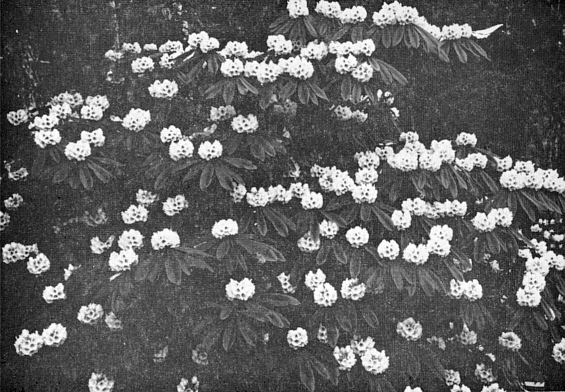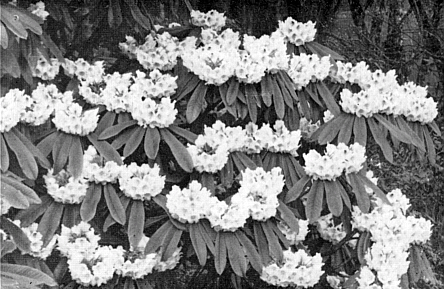QBARS - v18n4 Early Season Rhododendron Competition
Early Season Rhododendron Competition
Seattle, April 4 and 5, 1964
At the Clubhouse, University of Washington Arboretum
Frank Doleshy
Since this competition was something of a new departure in America, the evolution of the idea may be of interest. Impetus came, of course, from the fact that so many of the finest rhododendrons are in flower during April or earlier. With traditional U.S. shows timed to display the older hybrids, there was never the opportunity for massed showing of the other good things. The Seattle Study Group (a very informal organization within the Seattle Chapter) decided this year that such an opportunity should be provided, and we were delighted at the enthusiastic response throughout the Seattle Society.
Starting from this decision, we went ahead with some other ideas. First, we eliminated any separate classes for amateurs, commercial growers, botanical gardens-or people with red hair. Second, we ruled out all courtesy displays and required each entry to stand up to the competition. Third, we welcomed entries from American Rhododendron Society members anywhere, regardless of whether they were Seattle members.
Sweepstakes Won by Arboretum These rules gave us an open contest, with all emphasis on the quality of the plant material rather than the source. Amateurs, facing competition with nurserymen and the University of Washington Arboretum, seemed delighted to play in a big-league game. And the nurserymen and Arboretum seemed equally undismayed and entered things of the most unusual caliber. Based on points for each award, the Arboretum won the Sweepstakes Trophy by a margin of only 10 % over the amateur in second place, and the out-of-town nurseryman in third place followed even more closely. Two or three entries could have completely upset these rankings and, next year, probably will.
To a greater extent than usual, this was a do-it-yourself competition, with exhibitors preparing their own identification cards. And, through hard work by many committee members, we were economically provided with excellent staging, award ribbons and classification signs. However, there was no atmosphere of impoverishment, and the Study Group expenses of $188.17 included such pleasures as the entertainment of 15 guests at the awards banquet (but did not include publicity expense or a portion of postage expense, contributed by the Seattle Chapter).
Total expenses were perhaps one-tenth of a big-show budget, and provided a two-day free-admission display of 291 cut trusses and sprays, 65 plants, and 13 leaf and special exhibits, covering a great botanical range and staged with no small attention to proper classification and nomenclature.
The arrangement of cut material alphabetically by series, besides making things easy to find, turned out to be an artistic success. The individual classes contained harmonizing but diversified colors, and such series as Triflorum sprinkled the array with big, bright splashes.
Concerning future years, a major feature we have in mind is rotation of dates. Because of a late, cool spring, this year's competition brought in a surprising number of the earliest things. Next year we shall perhaps delay the date until April 15, then move to the end of April in 1966 and start over with a March date in 1967. Also, we are considering an additional midJune competition to bring in the late flowers which are also lacking on conventional show dates.
When selecting judges, we drummed up all possible hope that the competition would be worth the attention of Mr. and Mrs. Greig, from Royston, British Columbia, Mr. Alleyne Cook of Vancouver, and Mr. Carl S. English, Jr. of Seattle. All accepted with enthusiasm and decided as follows:

|
|---|
Fig. 47. A heavily blooming plant of R. calophytum in the garden of Carl Phetteplace showing the general growth habit of the plant. Photo by Carl Phetteplace, M.D. |

|
Fig. 48. Flower trusses of R. calophytum photographed in 1964. This is in the Phetteplace garden. Photo by Carl Phetteplace, M.D. |
| CUT TRUSS AWARDS | |||
|---|---|---|---|
No. of Species or Cultivars Represented |
|||
No. of Entries |
|||
Class |
Class Winner; Remarks |
||
3, Arboreum Series |
5 |
3 |
R. arboreum f. roseum (Chris Johnson) |
3H, Arboreum Hybrids |
8 |
5 |
'Werei' (H. L. Larson) |
5S, Azalea Series, Subseries Schlippenbachii |
5 |
1 |
R. schlippenbachii (Vera Ummel) |
5D, Azalea Series, all other deciduous species |
5 |
3 |
R. albrechtii (U. W. Arboretum) |
5H, All hybrid Azaleas and Azaleodendrons |
2 |
2 |
No awards. |
6, Barbatum Series |
3 |
3 |
R. monosematum (Lester Brandt) |
6H, Barbatum Hybrids |
2 |
2 |
'Fireball' (anonymous) |
7, Boothii Series and hybrids thereof |
19 |
9 |
'Snow Lady' (Betty Madison) |
9, Campanulatum Series |
1 |
1 |
R. fulgens (Herb Ihrig) |
18, Fortunei Series |
22 |
9 |
R. calophytum (Dr. & Mrs. John M. Shiach). Also received the Award for "Best Species Truss or Spray" by Mrs. J. Swift Baker. Interestingly, the 1st and 2nd place winners in this class were both white forms of R. calophytum. |
18H, Fortunei Hybrids |
8 |
7 |
'Avalanche' (H. L. Larson) |
21, Glaucophyllum Series |
5 |
1 |
R. glaucophyllum var. luteiflorum (Mrs. Stephen Anderson) |
22, Heliolepis Series |
1 |
1 |
R. rubiginosum (Lyn Davis) |
23, Irroratum Series |
2 |
2. |
No awards |
24, Lacteum Series |
1 |
1 |
R. dryophyllum (Frank Doleshy) Also received the Kingdon-Ward Memorial Award for best truss, spray or plant of any species native to Eastern Tibet. Any of almost 200 cultivated species could have received this award, and it is gratifying that the judges picked one of the neglected but beautiful and easily-grown pink and white Lacteums |
24H, Lacteum Hybrids |
4 |
3 |
'Mariloo' (Donald Graham) |
25P, Lapponicum Series, purple or violet flw. |
19 |
10 |
R. russatum (Johnson Rhod. Garden) |
25Y Lapponicum Series, white, yellow, pink or rose flower |
9 |
4 |
R. cuneatum (Lyn Davis) |
25H, Lapponicum Hybrids |
1 |
1 |
R. chryseum X R. spinuliferum (Rainier Mt. Alpine Gardens) |
26, Lepidotum Series |
3 |
1 |
R. lepidotum cv. elaeagnoides (Lyn Davis) |
270, Maddenii Series, grown outdoors |
9 |
2 |
R. johnstoneanum (U. W. Arboretum) |
271 Maddenii Series, grown indoors |
1 |
1 |
R. dalhousiae (U. W. Arboretum) Stopped every viewer in his tracks. |
27/29H, Maddenii and/or Moupinense Hybrids |
24 |
11 |
'Eldorado' (Mrs. Pendleton Miller) Also received the Mrs. Charles T. Jordan Trophy for Best Hybrid Truss or Spray. This rather little-known hybrid has a quality of color completely unlike the elepidote "yellow hybrids." The impression is one of golden tan rather than yellowish-green. |
Neriiflorum Series |
3 |
2 |
R. chamae-thomsonii (anonymous) |
Subseries Forrestii |
3 |
2 |
|
30N, Neriiflorum Series all other subseries |
9 |
5 |
R. beanianum (Bernard Swenson) |
30111, Forrestii Hybrids |
1 |
1 |
'Elizabeth' (Donald Graham) |
30112, Other Neriiflorum Hybrids |
3 |
3 |
Hybrid or unusual form of R. haemaleum (Ken Lauhon) |
32, Ponticum Series |
3 |
1 |
R. degronianum (Mrs. Pendleton Miller) |
3211, Ponticum Hybrids |
6 |
3 |
'Quaker Girl' (Mrs. Henry Isaacson). In this class, two Commended specimens of 'Rosa Mundi' were evidence of our tardy spring weather. |
33, Saluenense Series |
1 |
1 |
No awards. |
34, Scabrifolium Series |
19 |
5 |
R. racemosum (Mrs. Charles Sully) |
3411, Scabrifolium Hybrid |
12 |
6 |
'Racil' (Mrs. Linley Janzen) |
37, Taliense Series |
3 |
3 |
R. elegantulum (U. W. Arboretum) |
38W, Thomsonii Series, Subseries Williamsianum |
4 |
1 |
R. williamsianum (Harry Davidson) |
3811, Thomsonii Hybrids |
15 |
10 |
R. williamsianum X R. calophytum (Ed Arntsen) |
40, Triflorum Series |
25 |
4 |
R. Iutescens (Helen Kamphenborg) |
4011, Triflorum Hybrids |
8 |
3 |
R. keiskei X R. spinuliferum (Mrs. Linley Janzen) |
41, Uniform Series, and Hybrids |
11 |
4 |
R. pemakoense (Harry Davidson) |
43, Virgatum Series |
1 |
1 |
R. virgatum (Frank Doleshy) |
47, Any other hybrid |
8 |
8 |
'Gilian' (Donald Graham) |
50, Two leaves each of six different Rhododendrons, mounted one face up and one face down. |
12 |
1st place to Mrs. Henry Isaacson. The seven competitors variously emphasized indumentum, leaf shape, hybrid relationships, etc. Judges were most pleased and commended the exhibit as a whole. Mrs. Isaac son's entry was of such quality that it would be considered a showpiece by any herbarium. |
|
PLANT AWARDS |
|||
Class |
No. of Entries |
No. of Species or Cultivars Represented |
Class Winner; Remarks |
55, Young plant not more than 2½ feet tall of any Falconeri or Grande series species, or R. calophytum or R. beesianum |
1 |
1 |
R. fictolacteum (Lyn Davis) |
60, One standard flat containing species of any one series |
1 |
1 |
Neriiflorum Series (Ken Lauhon) |
70, Anthopogon Series, or Hybrid |
3 |
2 |
R. cephalanthum var. crebreflorum (H. L. Larson) Extremely popular with sophisticated viewers. |
72, Lapponicum Series, or Hybrid |
14 |
12 |
Unknown hybrid, Lappon. Series (Mrs. Stephen Anderson) |
73, Lepidotum Series, or Hybrid |
1 |
1 |
R. lepidotum cv. elaeagnoides (Rainier Mt. Alpine Gardens) |
74, Scabrifolium Series, or Hybrid |
8 |
4 |
R. spiciferum (Mrs. Henry Isaacson) |
75, Uniflorum Series, or Hybrid |
5 |
3 |
R. pemakoense (Mr.& Mrs. L. J. Inkster). Also received the Rainier Mt. Alpine Gardens Trophy for Best Species Plant. This specimen was large, shapely, and covered with flowers of unusually good pink color. |
80, Any other dwarf Rhododendron suitable for the rock garden. |
33 |
25 |
R. campylogynum var. myrtilloides (Helen Kamphenborg). Although not the Class 80 winner, H. L. Larson's 'Grievii' was a very attractive dwarf hybrid and won the Nelson Challenge Cup, for best hybrid plant exhibited. |

